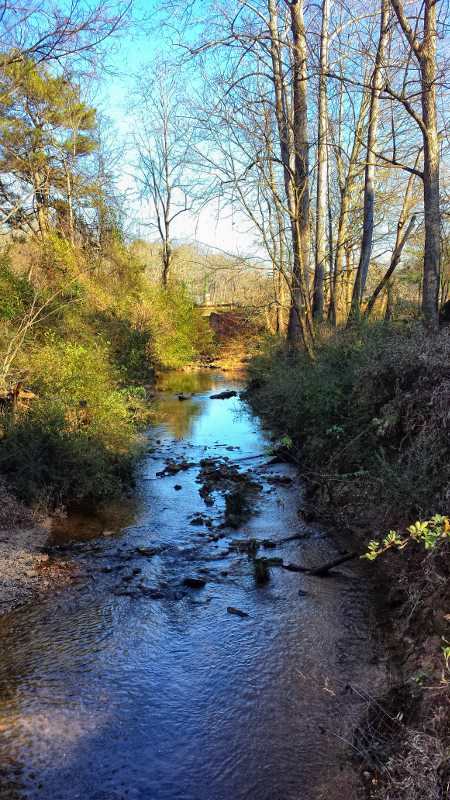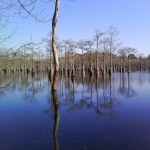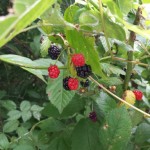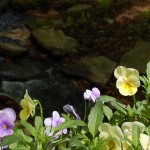I thought I’d celebrate my return to No Unsacred Place by musing upon the question of “why nature religion anyway?” I will say first that I don’t consider humanity and all our works to be essentially separate from nature; quite the opposite. I do think we ignore the non-human world at our peril and to our impoverishment. It’s a kind of narcissism to attend only to the doings of our own species, fascinating as they are. Looking outside of ourselves calls us to a deeper understanding of existence, on all levels, one that easily outstrips our capacity to comprehend in an ordinary sense. “Nature mysticism” might be a better phrase for what I mean. But to reach that kind of understanding, first you start with where you are.
“I come to Hollins Pond not so much to learn how to live as, frankly, to forget about it. That is, I don’t think I can learn from a wild animal how to live in particular–shall I suck warm blood, hold my tail high, walk with my footprints precisely over the prints of my hands?–but I might learn something of mindlessness, something of the purity of living in the physical sense and the dignity of living without bias or motive.” – “Living Like Weasels” by Annie Dillard
It is no secret to anyone who has been paying attention that I love me some Annie Dillard, most particularly her essay “Living Like Weasels,” which I am prone to give as assigned reading to my university students and my witchcraft students alike. It is that kind of work. I love her lithe and ferocious prose, her oblique but unmistakeable allusions to Thoreau, her juxtapositions. I love Thoreau too, though he is a little pompous. His curmudgeon saves him in my eyes; he says cranky and outrageous things about newspapers and post offices and the stupidity of people and makes me laugh. How he would loathe the Internet, while finding a way to make use of it; Thoreau, who lived a short stroll from town in Concord and made it sound like the edge of the wild. This in the mid 1800s when people knew from wilderness and frontiers.
I bring all this up because I am now living next to a pond, or a lake if you believe what it says about itself. It is the eponymous body of water belonging to Pine Lake, Georgia. Pine Lake is a tiny hamlet, once a resort where people would go in order to escape the hustle and bustle of Atlanta by building funky little cottages and fishing. Atlanta was the city then and Pine Lake was the country. That was in the 1930s. Now we are just past I-285, Outside the Perimeter in Atlanta’s parlance. Inside the Perimeter is city-cool; beyond that, in the outer darkness, the suburbs.
“This is, mind you, suburbia. It is a five-minute walk in three directions to rows of houses, though none is visible here. There’s a 55-mph highway at one end of the pond, and a nesting pair of wood ducks at the other. Under every bush is a muskrat hole or a beer can. “ – “Living Like Weasels”
Pine Lake isn’t quite like that; the houses gather near the lake like hunters warming their hands around a bonfire in winter, and while the Interstate is within shouting distance it is neither visible nor audible. Pine Lake wasn’t planned as suburban and is no development with cookie-cutter houses; rather it is resolutely individual, not to say quirky. There is also more than one pair of ducks. At either end of the lake is constructed wetlands, built with Federal grant money to help improve the water quality of Snapfinger Creek, and both the wetlands and the lake are full of life.
There are no weasels, that I am aware of. There are fish (mostly bream), turtles, and assorted frogs. There is a sinister troupe of Canada geese, the presence of which is a source of some consternation, many jokes, and quite a bit of goose poop. There is a possible fox, and definite beavers. There is a great blue heron.
The heron! It sometimes sits out on a half-submerged log, looking for dinner. It favors the marsh at the west end of town, where the creek flows away from the lake and passes out of the city limits. Once it sat on a tree limb outside our dining room window, preening.
I haven’t lived here very long, but I know the heron’s habits. At any time of day, more or less, I could catch a glimpse of it if I wanted to; all it requires is the time and willingness to walk along the trails to its favorite haunts, patience, and an observant eye. Some days, I don’t have the time to go heron-stalking; other days, I can see it from my window, and go walking just for exercise. Still others, I decide I want to see what’s going on at the other end of the lake where the mallards like to hang out, and don’t think about the heron at all unless it shows up unexpectedly. Whenever I see it, though, it draws my attention: regal, nearly silent, graceful, predatory, and singular.
The heron must be used to people, and yet it never lets you get too close. Draw parallel to it with the width of one of the marsh’s holding ponds between you, and it will duck its head, eyeing you with suspicion, then fly. I cannot approach the heron, certainly could never touch it; I can only look for it, entranced.
This is how I understand the divine, and why I continue to seek it in the resolutely non-human world, with which we nonetheless recognize a numinous kinship. Sometimes, it will turn and lock eyes with you, lifting you out of yourself, changing everything. Other times, it will give you the side-eye and swoop away, leaving you longing for retreating beauty. You might not see it every single time you go looking, or where you expect to find it. No matter how common the experience, every time you stumble across mystery, or independent wild being, it is a surprise and a miracle. And every day, you can look.












